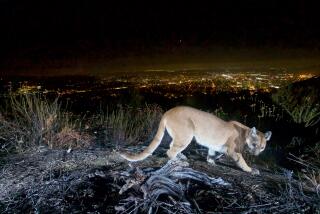Whiting Ranch park users on heightened alert for mountain lions
The face of a mountain lion — its eyes narrowed, jaw firmly set — greets every hiker and mountain biker who arrives at the trail head to Whiting Ranch Wilderness Park.
“Mountain lion in this area,” the poster reads, simply.
Here on the edge of suburban Orange County where the housing tracts give way to oak-studded hillsides and shoulder-high brush, plenty of day trekkers greeted the warning with a shrug on a recent weekday. But for some, one memory persists as a reminder of the dangers that lurk in the picturesque backcountry.
“I ride with a friend at all times because of what happened to Mark Reynolds 10 years ago,” said Kevin Gaffney, 43, of Seal Beach. “It woke a lot of us up.”
It’s been a decade since Reynolds was fatally mauled by a cougar as he changed a bicycle tire on a trail in Whiting Ranch and a woman was dragged into the brush, alive but seriously wounded.
Now, with recent mountain lion sightings, the park again is on alert.
The fatal mauling remains fixed in the minds of those who remember it, prompting them to take extra precautions, to be aware of their surroundings and to remain deferential to the animals in whose homes they are visitors.
“In Whiting Park there is a history of mountain lion activity,” said Andrew Hughan, spokesman for the California Department of Fish and Wildlife. “It’s not frequent and it’s not every day, or even every week or month, but there are lions in and out of Whiting Park. So if you use it, be aware.”
In 2012, a mountain lion in the park was trapped and taken to a conservation center after it was seen repeatedly roaming the same area over several days. And in 2008, a visitor reported being attacked by a cougar, but that report was never substantiated, said Tom Starnes, spokesman for Orange County Parks. The mountain lion that attacked Reynolds was later killed.
Attacks remain extremely rare.
“Being eaten by a shark or being hit by lightning — you have more chance of that than being attacked by a lion,” Hughan said. “But it has happened.”
A mountain lion was spotted Feb. 7 and again the next day, said Senior Park Ranger Steve Aleshire.
Soon a photo of the cougar began circulating on social media, blurry but clear enough to show the animal sitting in a tree near a trail that serves as an entrance to the park.
After the reports, rangers searched for signs of the cougar and found a paw print not far from the spot where the cat had been sighted. The print probably belonged to a juvenile less than 2 years old, Hughan said.
Reported sightings aren’t unusual. In fact, there have been more than 200 in Orange County parks in the last seven years, according to county data. Often, the reports turn out to be false alarms — someone mistaking a bobcat, a dog or even a large house cat for a mountain lion, Hughan said.
It was the combination of sightings over two days, a photo and a paw print that raised concerns this time. It’s rare for mountain lions to stay in one place for extended periods — males have ranges up to 250 square miles and females up to 150.
But since then, there have been no further sightings, and rangers who placed cameras in the area have yet to get an image of the animal.
On Friday, Aleshire and two park rangers walked the trails in the wilderness park to retrieve video recordings and look for scat, prints and anything else that might signal that a cat is still around. They stopped to examine the ground where a trickle of water crossed the trail.
“When we look for tracks, we look near watery areas because it’ll hold a print,” Aleshire explained. But there was nothing.
In recent days, Aleshire said, rangers have been answering questions from visitors and handing out yellow fliers that explain what to do when hiking in mountain lion country. The flier reminds visitors that they are safer hiking in groups than alone and that, should they encounter a cougar, the best thing to do is hold their ground, wave their hands and shout.
The park is a refuge for countless families and individuals looking to escape the surrounding sprawl into a world of oak woodlands and coastal sagebrush. Many frequent the park and were mindful of the precautions even before the recent sighting, Aleshire said.
Many also know well the story of what happened to Reynolds and to Anne Hjelle, the woman who was mauled.
In 2012, Hjelle told her story in her book “Skin Deep.” In it, she recounts in detail the brutal attack and the friend and fellow bikers who came to her aid, fighting off the animal with kicks and rocks.
“I was shocked by it,” said Gaffney, the mountain biker from Seal Beach. “It’s one of those things, you have to realize it’s a nature park.”
Hjelle was left with severe injuries, particularly to the left side of her face, and she endured years of recovery. But she’s still an avid, though cautious, mountain biker, and she has even returned to Whiting Ranch, most recently in January to mark the 10-year anniversary of the attack.
Occasionally, she said, she’ll hear from someone who says they used to hike or mountain bike until they heard about what happened to her and Reynolds.
“That’s the thing that makes me sad,” she said. “I think we have to be safe. But it’s not a reason to not go into the parks.”
More to Read
Sign up for Essential California
The most important California stories and recommendations in your inbox every morning.
You may occasionally receive promotional content from the Los Angeles Times.











